Finding Bunny's Footprints in the Heavens!
Magical bunnies, like Bunny of Bunny Hollow, do not always stay in forests. Sometimes, just for fun, they play among the stars! And sometimes, you can even see their footprints in the heavens! To find them you must first learn what bunny footprints look like.
|
Imagine, in slow motion, a rabbit running across the hills. See how he plants his front paws on the ground, one after the other in a line. He leaps, and his two back feet come down together, side by side in front of the line of the first two prints. He leaps again and again to repeat the pattern, over and over. Anyone can recognize rabbit tracks right away, and can easily recognize them in the sky once one knows where to look. |
 |
Now that you know what bunny footprints look like; you can begin tracking magical bunnies in the sky. The next step is to become familiar with the Scorpion, who lives in the heavens. He looks like a curving string of stars resembling a fishhook or the letter "J". The first time the entire Scorpion can be seen in the sky during the year (in the northern hemisphere) is in February just before the Sun rises. He is BIG, lives low on the southern horizon and moves from the east to the west. As each month passes you can see him rising earlier and earlier until he is up in the sky way before the Sun rises. By the time August rolls around you can easily see him all night long on cloudless nights, if you have an open horizon to the south.
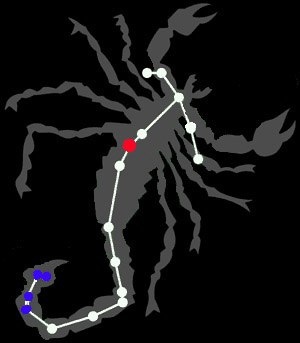
The Scorpion also known as the constellation Scorpius has one bright, reddish, star that gleams among his curving chain of stars. This is the Scorpion's heart. This red star is called Antares and rivals the planet Mars with its ruddy coloring. The orbit of Mars often places it near Antares and as a result many people confuse the two. Before Mars was called Mars by the Romans, it was called Ares by the Greeks. Antares literally means "against Ares," "the Rival of Ares." This red heart star will help you find the Scorpion in the sky. Once you find Scorpius look for a grouping of stars which forms his stinger, the tip of the fishhook, or the end of the "J". These stars are Bunny's footprints! You might wonder how this could be ...
 |
... Well, it seems that Bunny became good friends with Scorpius as he played among the stars and the Scorpion promised never to sting Bunny! As a sign of his friendship, Scorpius made his stinger look like Bunny's footprints and whenever Scorpius waves his tail, it's a sign for Bunny to come and play! |
The Navajos may have been the first to recognize these stars as "Rabbit Tracks." From these tracks, they could picture the rabbit hopping along in the sand, and if they were hungry enough, rabbit might appear to them offering itself as food. For the Navajo, these four stars are "the Hunters Guide." They appear just before sunrise when winter weather breaks. Earlier and earlier they rise as the young rabbits are born down here on Earth. By summer, they are standing upright in the evening sky as darkness comes. When fall arrives, they are tipped on an angle to the southwest: the signal for Navajos that it is time to hunt.
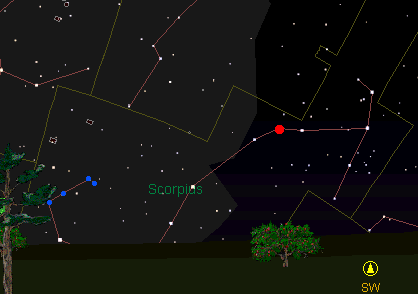
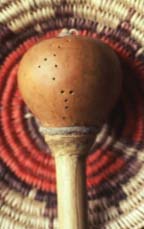 |
Certain Navajo ceremonies make use of gourd rattles with small drill holes showing stars. The patterns differ from rattle to rattle, but frequently one can recognize Rabbit Tracks among them. In addition, the classic Navajo sand painting of Mother Earth and Father Sky includes recognizable star patterns, one of which is Rabbit Tracks. |
| Rabbit tracks are well known in Native American rock art. Along the banks of the Colorado River in southeast Utah there is a petroglyph panel (shown here) that includes a line of rabbit tracks. Also the famous Newspaper Rock located in the Needles District of Canyonlands National Park has sets of rabbit tracks running through the center of the collection of images. |
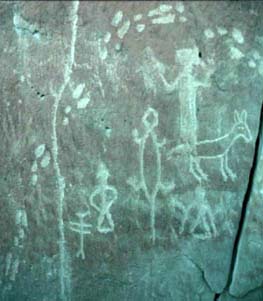 |
Tracking Bunny's Footprints in the Sky
These four gleaming stars in the Scorpion, which the Navajo call the Rabbit Tracks, can be found in the sky throughout the year with the exception of two months. The table below gives you a pretty good idea of when and where to look along the southern horizon. Look for a pair of tracks close together, side by side, with another, more widely separated pair in a vertical line below.
| Feb-Mar. | Look to the southeast just before sunrise. |
| Apr-May | Look to the southeast around midnight and to the south just before sunrise. |
| June-July | Look to the southeast in the evening, to the south around midnight, to the west just before sunrise. |
| Aug-Sept. | Look to the south in the evening, to the west around midnight. |
| Oct.-Nov. | Look to the west in the evening. |
| Dec.-Jan. | The Rabbit Tracks are invisible to us now, below the horizon. |
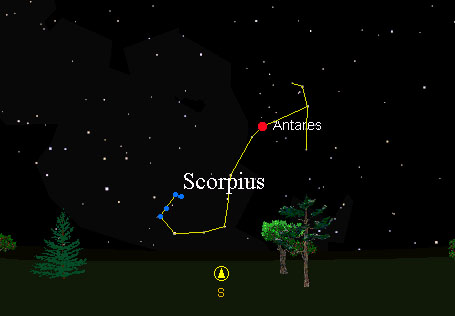
This pattern of stars that make up the tail of Scorpius is a perfect set of rabbit tracks. Remember what they look like; allow their magic to sparkle in your heart and in your mind's eye; then, look for them in the sky. Perhaps you can even find another group of stars that remind you of Bunny's playful tracks. Go out and find them. Look for them in the sky, the sand and the snow!
Thanks, Von Del Chamberlain, for the Native American images and insights!
Your friends at Bunny Hollow
Look
Up! ~ Links
Links to star maps, sky calendars and more.
Discovering
the Heavens
The Night Sky
The Planets
SouledOut.org Home